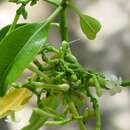Comprehensive Description
(
الإنجليزية
)
المقدمة من Smithsonian Contributions to Botany
Ochrosia nukuhivensis Fosberg & Sachet
Ochrosia nukuhivensis Fosberg & Sachet, Micronesica 8:48, 1972.
Ochrosia parviflora sensu F. Brown, Flora, 232, 1935 [pro parte, non (Forster f.) G. Don, Gen. Hist. 4:99, 1838].
Glabrous tree; leaves in whorls of 3, blades 5 × 15 cm, elliptic, tapering to both ends, veins visible on both surfaces, widely divergent, about 5 mm apart, with an anastomosing network between; petioles 3 cm long; young cymes to 2.5 cm long, loosely branched about 3 times; in bud only, sepals less than 1 mm high, very obtuse, wider than high, corolla in bud 7 mm long, tube 5 mm, lobes slightly twisted to left, fruit unavailable.
Probably related to O. tahitensis Lanessan.
Known only from the type-specimen.
SPECIMEN SEEN.—Nukuhiva I.: Mauu, Brown 432 (BISH, type).
Plumeria L.
Plumeria L., Gen. Pl., ed. 5, 99, 1754 [=1753].
Shrub or small semideciduous trees with leaves and cymes clustered at ends of very thick branches; cymes corymbiform, corollas showy, salverform-funnelform, without appendages; anthers obtuse; fruit a pair of large rather woody divaricately divergent follicles.
An American genus, of which two species are among the commonest and showiest tropical ornamentals and are prized for their fragrant flowers. The less frequently cultivated Plumeria obtusa L., with dark green, leathery, obtuse leaves and white flowers, is found in Tahiti and may be expected in the Marquesas.
- الاقتباس الببليوغرافي
- Sachet, Marie-Hélène. 1975. "Flora of the Marquesas, 1: Ericaceae-Convolvulacae." Smithsonian Contributions to Botany. 1-38. https://doi.org/10.5479/si.0081024X.23

